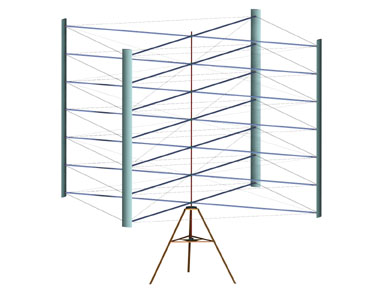Wind Power Systems
Empire Magnetics Partners with State Rocket Center to Design Low Maintenance Wind Power Systems The U.S. Department of Energy (DOE) recently announced funding of a proposal submitted by Lawrence Berkeley National Lab and Empire Magnetics Inc. Over the next two years, $1.3 million of a total of $36 Million appropriated by the US Congress for International Proliferation Prevention will be dedicated to the design and prototyping of new windmill technology. The program, officially named LBNL-T2-0203-RU Low Maintenance Wind Power System, is an outgrowth of collaboration between scientists and engineers at Lawrence Berkeley Labs, The Makeyev Design Bureau of the State Rocket Center in Miass Russia, and Empire Magnetics Inc. |
 |
These small (3-70 kW) wind power systems use a novel Vertical Axis Wind Turbine (VAWT) design. VAWT offers a number of advantages over conventional Horizontal Axis Wind Turbine (HAWT), such as lower maintenance costs and increased durability and reliability. VAWT systems are also more economically viable in remote locations than 100+ kW HAWT systems. Empire Magnetics will be engineering the alternators for these windmills. According to a report by the American Wind Energy Association (www.awea.org), over the last five years growth of the wind power market averaged 30% annually, with 2001 sales topping $7 Billion, and a total of 6500 megawatts added to the grid worldwide in 2001 alone. The multi-billion dollar wind power industry is the world's fastest growing energy source and is growing in popularity in an effort to reduce carbon dioxide emissions, and to generate cost-effective electricity in remote locations. These windmills are being proposed as power sources in the effort to help rebuild Afghanistan. Empire Magnetics Inc. has been providing specialized equipment to the national labs for many years. As a result the company was in a position to pull together several programs to put together a plan which, according to the USIC (http://www.usic.net/) review committee was, “The best proposal submitted this year.” This plan has teams of Russian missile, aircraft, submarine and other disciplines working to create advanced windmill designs. The expertise in aerodynamics, mechanical structures and other related areas directly transfer to this peaceful and environmentally friendly purpose. Empire Magnetics Inc. will use its expertise in motor technology to design and build improved alternator technology to be used with these windmills. At LBNL, Daryl Oshatz (daryl_oshatz@lbl.gov) is the project manager, while Glen Dahlbacca PhD. manages the overall LBNL IPP program. Over the last five years Rick Halstead, CEO of Empire Magnetics, has developed a relationship with a private group of engineers in Russia. This group has been providing engineering design services for electric motors and mechanical design projects. As a result Empire has developed the communications and management team in Russia, considered key to the success of the program. In addition, Dean Wieberg of the Jet Propulsion Labs in Pasadena, CA, now serving on the board of directors for Empire Magnetics Inc., has been helpful in providing technical and administrative guidance to the company. Recognizing that even a small windmill market share will be a much larger enterprise than Empire is today, a new company, Wind-Sail is being formed to market the windmill systems. Richard McClellan Ph.D., well known in Sonoma County for his successful venture at Compumotor, now a division of Parker Hannifin, is CEO of Wind-Sail and is taking the lead in developing this business. "New market opportunities are emerging around the world for inexpensive, small-scale power stations. In many locations a modern wind farm or single HAWT capable of generating hundreds of kilowatts is no more appropriate than would be a coal or natural gas-fired power plant. In Russia, India, China and numerous remote locations in the developed and developing world, the expense of fossil fuel based power makes renewable energy sources and, specifically, wind power an extremely attractive alternative," says Dr. McClellan. A second company in Russia is being formed to move scientists and production from government to private control. Venture capitalists, having done well supporting Dr. McClellan in the past, are assembling a group to fund these new enterprises. Dr. McClellan can be reached at Empire’s offices (ph 707-584-2801).
|
|